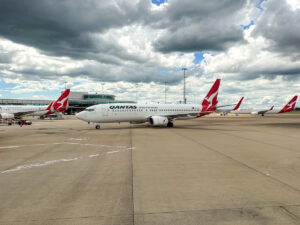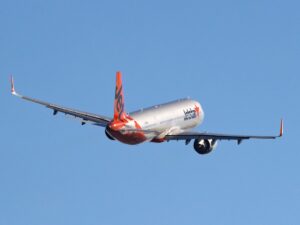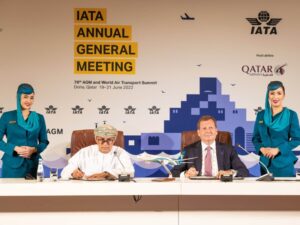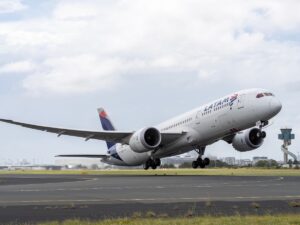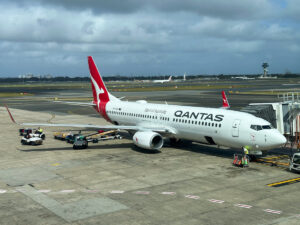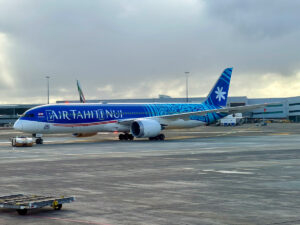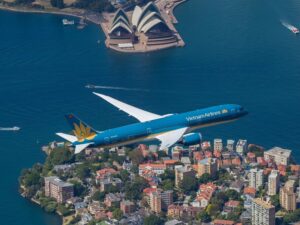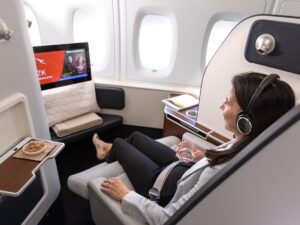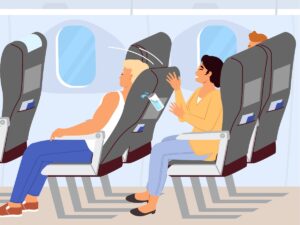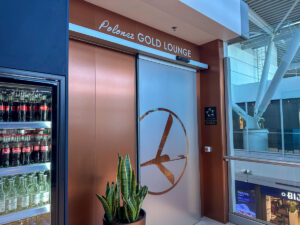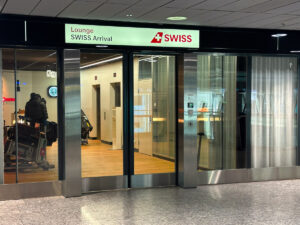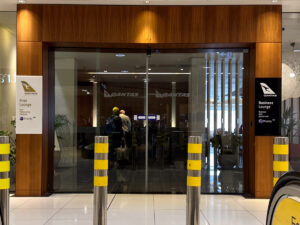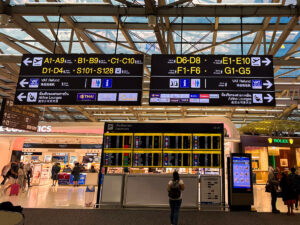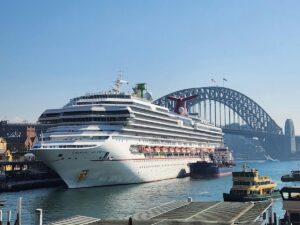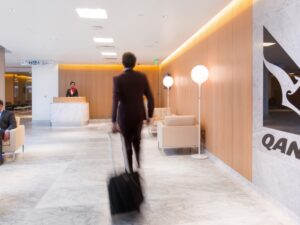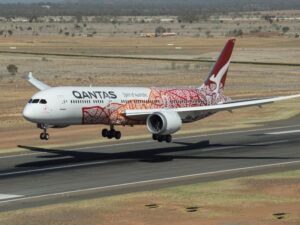
Over the past few years, Joe Aston’s trenchant Rear Window columns in the Australian Financial Review have caused quite a stir, highlighting many of Qantas’ shortcomings and culminating in the airline removing the newspaper from its airport lounges.
But that was nothing compared to the public reaction to the allegation on page 230 of Aston’s new book, The Chairman’s Lounge, that Prime Minister Anthony Albanese “would liaise with [Qantas CEO Alan] Joyce directly about his personal travel”. The implication being – although the book does not explicitly state this – that Joyce would give confirmed upgrades at Albanese’s request.
This revelation predictably made headlines for days, with Albanese eventually denying after almost a week that he’d ever personally asked the Qantas CEO for an upgrade.
The story prompted a much-needed public discourse about the perception that politicians accepting free Chairman’s Lounge membership from Qantas could create a conflict of interest, especially when those same politicians are responsible for regulating the airline and its industry.
Several independent politicians cancelled their memberships in the wake of this, and it shone a light on Qantas’ immense lobbying power in Canberra. This included the government’s questionable decision in 2023 to block additional Qatar Airways flights into Australia – something that has possibly backfired now with Virgin Australia launching its own flights to Doha.

It turns out, according to Aston’s book, that Qantas was also a key factor in stalling Qatar’s pre-COVID application to add flights to Brisbane for several years. The book also claims that Qantas was primarily lobbying against Qatari air rights at the behest of Emirates – a claim that Emirates President Tim Clark has denied.
Those are the parts of the book that made headlines when it was released in October 2024. But The Chairman’s Lounge is much more than just a book about Qantas’ relationship with the federal government.
Numerous AFF members have asked me for my thoughts about this book. In short, I found it to be a great read and if you’re interested in the kinds of topics we cover on Australian Frequent Flyer, I’d say it’s worth adding it to your Christmas reading list.
In this review, I’ll share my opinion about the book and its contents, my insights on some of the issues raised, and some of the book’s key revelations that you might have missed.
For the record, I’ve been given no incentives to write this review. These are just my personal thoughts and reflections on a book – and a time in Australian aviation history – that clearly is of great interest to the Australian Frequent Flyer community.
Contents
This book is a fascinating case study about leadership
The Chairman’s Lounge is a detailed and fascinating case study of what happened when a good business, with good leadership, slowly and then very quickly lost its way.
It’s a story about power corrupting humility. How a once highly-respected, strongly performing CEO became too focused on short-term profit and too obsessed with his own public image – at the expense of customers, the company’s staff and the public. How he started acting like a politician, while at the same time claiming not to be a public figure when it helped him to avoid scrutiny.
It’s a story about how Alan Joyce’s leadership style shifted gradually from a collaborative one to a “command and control” approach. When Joyce first became Qantas CEO, Aston writes, someone would be designated in important meetings as the “devil’s advocate” whose job it was to question bad ideas. This went by the wayside, and Qantas staff became afraid to tell Joyce things he didn’t want to hear.
Finally, it’s a sobering tale about poor governance from an ineffective board, led by a weak chairman, that failed to reign in a CEO that was destroying the company’s reputation.
Some directors were indeed aware of what was happening and tried to bring various issues to the CEO’s attention – something that the book claims “annoyed Joyce”. But, as Aston writes, “The problem was the directors’ weak acceptance of [Joyce’s] magical explanations, and their unwillingness to create a genuine conflict situation at the boardroom table when one was needed.”
You don’t need to be an aviation or finance nerd to enjoy this book
If you’re interested in Qantas and the Australian aviation industry, The Chairman’s Lounge is a must-read.

But its broad themes are not specific to aviation. Many of the lessons could be applied to any large business.
The Chairman’s Lounge is just as much about leadership as it is about the business of running an airline, so it’s definitely a worthwhile read if you’re interested in business management or want to become a better leader.
It’s also worth a read if you’re interested in Australian politics, as there is quite a lot of this intertwined into the narrative. Though, as I said, there is more to the book than just what was reported in late October.

Certainly, Aston goes into quite a lot of detail about the inner workings of the airline, including some of its financial decisions. That’s not surprising, given the author’s background as a Financial Review columnist. But what I liked about Aston’s writing is that he also explained key financial concepts well. So, you don’t need to be an expert in finance to understand the key issues. And there are some big ones!
Aston alleges, for example, that Joyce manipulated the company’s share price for his personal gain. He also shows plenty of examples of times that Qantas fudged numbers, obfuscated and, unfortunately, misled the public. Like in 2023, when it went to great lengths to hide the true value of unredeemed flight credits, while at the same time claiming to be “very transparent”.
Aston’s writing style itself is witty, insightful and incisive. In that sense, the book can at times be quite an entertaining read as well.
Many AFF members experienced the customer service failures identified in the book
If you’ve been a Qantas customer or employee in recent years – or even just an Australian taxpayer – there’s a good chance some of the issues Aston brings up will resonate with you.
Certainly, many of us on AFF had our fair share of issues with redeeming Qantas flight credits. Many of us experienced the long call centre wait times, mass cancellations, missing bags, poor catering, and more, particularly in 2022 when the airline was trying to ramp its operations back up after the great COVID hibernation.
In fact, on page 122, Aston directly references the AFF members whose bookings were accidentally cancelled by inexperienced Qantas call centre staff.

Aston says that, after he started writing regularly about Qantas, he got inundated with emails from disgruntled customers sharing their own Qantas horror stories. I can certainly relate to that. I received so many messages with tales of woe that I couldn’t have possibly covered them all.
Was Qantas management living in a parallel universe?
Clearly, things were not going well for Qantas throughout 2022 and much of 2023. Arguably, you’d have to be denying reality to see it otherwise. Yet, as Aston writes, Qantas management kept publicly claiming that things were great and customer service was back to pre-COVID levels. Customers saw through it and didn’t like being taken for fools.
There was a clear dissonance between what management believed was happening, what management said was happening, and what was actually happening. Either way, some customers got the impression that Qantas’ executives were unaware of the issues actually facing customers.
This, by the way, is one of the things that personally bugs me about politicians being gifted Chairman’s Lounge membership. As a result, they get looked after really well and get direct phone access to a VIP Service Team. It’s great for them, but it means they don’t experience flying in the same way as the vast majority of the Australian public. Which means they don’t get the full picture of what’s going on.
(Platinum One frequent flyers can also access that special call centre, but most Australians obviously do not have that status tier.)
Joyce particularly struggled with criticism towards the end
Joyce took credit for things that went right, while externalising failures. And he didn’t take criticism well. This was part of the problem.
I met Alan Joyce at a media event in early 2023, and we had a pleasant enough chat for a few minutes about Qantas relaunching flights to Hong Kong. But when the conversation progressed, and I think he might have got the sense that I wanted to ask some real questions – you know, as journalists sometimes do – he changed the subject and announced, “Who wants photos?”.
In May 2023, Qantas announced that Vanessa Hudson would take over as Qantas CEO. At that press conference, Joyce, Hudson and chairman Richard Goyder painted a rosy picture about Qantas’ exceptional financial shape. But as Aston describes on page 197, when they opened the floor to questions, “the press gaggle had descended from an alternative universe.” They were more interested in asking about the airline’s damaged reputation and the hostility it had shown towards some of its workers.
I attended numerous Qantas press conferences over the period covered in the book, and this was a common pattern. The Qantas executives would rattle off their talking points, then the waiting journalists would ask questions that had little or nothing to do with the thing Qantas was actually announcing that day.
At times, the questions coming from the press pack could be hostile. They were often about flight credits, cancellations or customer service issues. And frankly, that reflected the public’s mood at the time. Those were the things most concerning the journalists’ audiences.

I felt sorry for Qantas’ PR team
It doesn’t surprise me that Qantas would want to control the public narrative. Every big business does. But, as the book reveals, Joyce took particular exception to Joe Aston’s columns. He felt that they were unfair personal attacks. Rather than address the substance of the columns, he tried to stop Aston from publishing them.
It was already public knowledge that Qantas removed the offending newspaper from its lounges and planes in retaliation against Aston’s articles. But my jaw dropped when I read what else Qantas tried to stop Aston publishing his critical columns. This included both Joyce and Goyder personally meeting Australian Financial Review editor-in-chief Michael Stutchbury to complain.
Aston writes that many other newspaper editors would have folded under that kind of pressure. But Stutchbury told Joyce – for the second time in a matter of months – that he wouldn’t tell Aston to stop writing about the airline. He would happily correct any factual errors – but Qantas was reportedly unable to point to any specific examples. (By the way, I have a great deal of respect for this approach and it aligns very closely with AFF’s editorial policy.)
Joyce was reportedly furious, and his efforts to silence his biggest public critic ultimately backfired. What Aston was writing was generally true and resonated deeply with the public. This included, embarrassingly for Qantas, the Australian business community that reads the Financial Review.
At the same time as this was happening, Joyce apparently became so obsessed with the media coverage about Qantas that he would read every article and watch every TV clip before 6am every morning.
I can only imagine how difficult it would have been to work in Qantas’ PR department under such circumstances. I personally know many of the people who were working in that team, and I genuinely feel sorry for them. It sounds like that would have been a particularly challenging place to work during that tumultuous post-COVID period.
The ACCC “ghost flights” action
In August 2023, the ACCC announced it was investigating Qantas for selling tickets on flights it had already cancelled. With public trust in Qantas already at record lows, this would prove a fatal blow for Joyce’s leadership.
This is covered extensively in the book, but I want to share some of my own thoughts on this.
When I first heard about this, I was immediately reminded of an article I’d worked on almost two years earlier. In October 2021, after a long COVID shutdown, Australia finally started to announce the reopening of its international border. Qantas, as you would expect, quickly got to work putting international flights back on sale. But when I sat down and had a look at the international schedule it was selling in October 2021, for travel in 2022, I thought it seemed overly ambitious.
Many of Qantas’ planes were still parked in the desert, so I did some calculations to see whether Qantas would actually have enough planes available to operate all the flights it was selling. I soon came to the realisation that it would be impossible.

I asked Qantas about this at the time and they didn’t seem too concerned about what I was saying. They were concerned, though, about the negative publicity they might get if a mainstream media outlet picked up on my story.
Qantas did not dispute my calculations, which I’d double-checked, but insisted they would look to get more planes into service if needed. (If only it were that simple.) Besides, the schedules were just indicative and if they did cancel someone’s flight, they would rebook or refund them. I’m paraphrasing here, but that was the gist of it.
In fairness, the international restart was complex and governments were still changing border restrictions regularly. So it would have been impossible to accurately predict in 2021 where there would be demand in 2022. But, looking back, that does seem to me like an early version of Qantas’ “bundle of rights” defence to the ACCC.
I suspect many of Qantas’ customers were much less relaxed about the inconvenience of having their flights cancelled. Some might have paid more to fly at a particular time that better suited them. Others might have already made prepaid bookings based on their original flight schedule. And in practice, Qantas often ended up taking weeks to inform customers after deciding to cancel their flight. Meanwhile, alternative flights had become more expensive.

It turns out that the ACCC didn’t take too kindly to Qantas’ post-COVID era practice of selling tickets on flights it didn’t intend to operate, either. Qantas paid a $100 million fine in that settlement – although that fine was actually for the lengthy delays in informing customers about their cancellations – and agreed to pay $20 million in compensation to customers.
Revelations about Qantas’ prickly relationship with Qatar Airways
Aston’s book also contains some interesting insights into the soured relationship between former Qatar Airways CEO Akbar Al Baker and Alan Joyce.
Unlike Joyce, Al Baker agreed to be interviewed for the book. One of Al Baker’s interesting claims is that Joyce had personally told him in October 2021 that Qantas was “very interested” in working with Qatar once its alliance with Emirates expired in 2023. This wasn’t the first time Joyce had made this pledge. Two days after that meeting, Qantas and Emirates announced another five-year extension of their partnership.

Al Baker claims that he felt Joyce was dishonest in his dealings with him. The next year, Qatar Airways announced the first phase of its partnership with Virgin Australia. Meanwhile, Qatar started blocking Qantas frequent flyers from accessing most of its reward seats.
In 2022, the book claims, Qatar Airways tried to have Qantas kicked out of the Oneworld alliance. Qantas took the threat seriously, both by working to shore up support from other alliance members and preparing for the real possibility that it would have to leave.

Qantas is now under new leadership
All in all, it’s a bit of a sad story. But there is a silver lining.
The events in this book took place recently enough that most of us remember them well. But they are history. The airline is now very much under new management, and thank goodness for that.
Having vociferously exposed Qantas’ failures, the book ends on a kinder note. It points out that a major cultural change in the organisation is already well underway, under the leadership of Hudson and incoming chairman John Mullen.

Qantas’ PR team is back on speaking terms with Joe Aston. In fact, Aston says they’ve become much more helpful and prepared to answer questions truthfully, even when the answer is unflattering.
But some of the company’s more questionable decisions will still be on raw display for some time. For example, Qantas made a lot of experienced staff redundant during the pandemic. It will take time to replace the staff that were lost, and for the new hires to build up the experience that was lost. The airline is working on that, and there has been a positive shift in the way it negotiates agreements with its staff.
Joyce’s longest-lasting legacy could well be his lack of capital expenditure on new aircraft. In order to reduce costs in the short term – thus boosting profit – Joyce delayed ordering new planes and the company abandoned its philosophy of maintaining a younger fleet. Qantas does now have lots of new planes on order, but these are due to arrive over the next decade.
Meanwhile, today, the condition of Qantas’ existing fleet is in decline and the aircraft it does have need more maintenance.
It recently had to bring a Boeing 717 out of retirement, twice, just to cover its domestic schedule.

Qantas doesn’t have enough long-haul jets either, so it’s using Airbus A330s without proper crew rest facilities on 13-14 hour flights. The Australian cabin crew won’t even agree to work those flights, so Qantas had to call in Jetconnect crew.
It’s also resorted to wet leasing dozens of jets from Alliance Airlines and Finnair.

At the end of the day, most of us will be back because of Qantas’ extremely effective loyalty program. As Aston pointedly remarks, “the 62 per cent of the Australian population who were [Qantas Frequent Flyer] members were more likely to know the points balance of their frequent flyer account than their superannuation balance”.
A reminder of the value of investigative journalism
Finally, The Chairman’s Lounge reminded me of the importance of investigative journalism. I’ve been paying fairly close attention to Qantas in recent years, and there was a lot in the book that I already knew about, but even I was surprised by some of the revelations I was reading. And not in a good way.
It turns out that Qantas got away with quite a lot. At least there were people holding the company that received $2.7 billion in taxpayer money during the pandemic to account. Not everyone in the media was doing this effectively – especially when, as Aston points out, Qantas exerts a lot of soft influence over not just the government, but also the media.
Some may criticise the author for focusing too much on Qantas’ failures when the entire aviation industry was struggling through the post-COVID boom. Other airlines including Air Canada also had questionable conduct when it came to refunds and flight credits.
But this is a book about Qantas, after all. Overall, I do think that Aston was reasonably fair in pointing out when Qantas did get things right, and conversely focusing on the failures that were unique to Qantas rather than industry-wide.
Where to get a copy
If you’ve made it this far into my article – and haven’t lost interest yet – firstly, congratulations. Secondly, there’s a good chance you’ll enjoy reading The Chairman’s Lounge!
It’s available now in good bookstores. But if you appreciate a bit of irony, why not order it online through the Qantas Online Mall and earn a few frequent flyer points for your purchase?
If you have Accor Live Limitless Platinum or Diamond status, you can also use the 25 Euro Rakuten Kobo gift card that you get with your membership towards the eBook version. (For a bit more irony, Accor is also a partner of Qantas Frequent Flyer. It really is the Aussie loyalty program with tentacles everywhere!)
